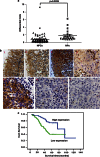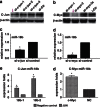Loss of connective tissue growth factor as an unfavorable prognosis factor activates miR-18b by PI3K/AKT/C-Jun and C-Myc and promotes cell growth in nasopharyngeal carcinoma
- PMID: 23681229
- PMCID: PMC3674361
- DOI: 10.1038/cddis.2013.153
Loss of connective tissue growth factor as an unfavorable prognosis factor activates miR-18b by PI3K/AKT/C-Jun and C-Myc and promotes cell growth in nasopharyngeal carcinoma
Erratum in
- Cell Death Dis. 2013;4:e672
Abstract
Connective tissue growth factor (CTGF) has different roles in different types of cancer. However, the involvement and molecular basis of CTGF in tumor progression and prognosis of human nasopharyngeal carcinoma (NPC) have almost never been reported. In this study, we observed that downregulated CTGF expression was significantly associated with NPC progression and poor prognosis. Knockdown of CTGF markedly elevated the ability of cell proliferation in vivo and in vitro. Subsequently, we discovered that the reduction of CTGF increased the expression of miR-18b, an oncomir-promoting cell proliferation. Further, we discovered that attenuated CTGF-mediated upregulation of miR-18b was dependent on the increased binding of transcription factors Jun proto-oncogene (C-Jun) and v-Myc myelocytomatosis viral oncogene homolog (C-Myc) to miR-18b promoter region via phosphoinositide 3-kinase (PI3K)/AKT pathway. Finally, we further found that miR-18b directly suppressed the expression of CTGF in NPC. In clinical fresh specimens, miR-18b was widely overexpressed and inversely correlated with CTGF expression in NPC. Our studies are the first to demonstrate that reduced CTGF as an unfavorable prognosis factor mediates the activation of miR-18b, an oncomir directly suppresses CTGF expression, by PI3K/AKT/C-Jun and C-Myc and promotes cell growth of NPC.
Figures






Similar articles
-
Tumor suppressor PDCD4 modulates miR-184-mediated direct suppression of C-MYC and BCL2 blocking cell growth and survival in nasopharyngeal carcinoma.Cell Death Dis. 2013 Oct 24;4(10):e872. doi: 10.1038/cddis.2013.376. Cell Death Dis. 2013. PMID: 24157866 Free PMC article.
-
VPS33B interacts with NESG1 to modulate EGFR/PI3K/AKT/c-Myc/P53/miR-133a-3p signaling and induce 5-fluorouracil sensitivity in nasopharyngeal carcinoma.Cell Death Dis. 2019 Apr 3;10(4):305. doi: 10.1038/s41419-019-1457-9. Cell Death Dis. 2019. PMID: 30944308 Free PMC article.
-
miR-3188 regulates nasopharyngeal carcinoma proliferation and chemosensitivity through a FOXO1-modulated positive feedback loop with mTOR-p-PI3K/AKT-c-JUN.Nat Commun. 2016 Apr 20;7:11309. doi: 10.1038/ncomms11309. Nat Commun. 2016. PMID: 27095304 Free PMC article.
-
Regulatory role of miRNAs in nasopharyngeal cancer involving PTEN/PI3K/AKT, TGFβ/SMAD, RAS/MAPK, Wnt/β-catenin and pRB-E2F signaling pathways: A review.Cell Biochem Funct. 2024 Mar;42(2):e3945. doi: 10.1002/cbf.3945. Cell Biochem Funct. 2024. PMID: 38362935 Review.
-
Targeting CTGF in Cancer: An Emerging Therapeutic Opportunity.Trends Cancer. 2021 Jun;7(6):511-524. doi: 10.1016/j.trecan.2020.12.001. Epub 2020 Dec 25. Trends Cancer. 2021. PMID: 33358571 Review.
Cited by
-
Identification of miRNA/mRNA-Negative Regulation Pairs in Nasopharyngeal Carcinoma.Med Sci Monit. 2016 Jun 28;22:2215-34. doi: 10.12659/msm.896047. Med Sci Monit. 2016. PMID: 27350400 Free PMC article.
-
lncRNA GHET1 knockdown suppresses breast cancer activity in vitro and in vivo.Am J Transl Res. 2019 Jan 15;11(1):31-44. eCollection 2019. Am J Transl Res. 2019. PMID: 30787968 Free PMC article.
-
Micro-ribonucleic acids: potential noninvasive biomarkers for hepatocellular carcinoma.J Hepatocell Carcinoma. 2014 May 21;1:21-33. doi: 10.2147/JHC.S44463. eCollection 2014. J Hepatocell Carcinoma. 2014. PMID: 27508173 Free PMC article. Review.
-
The role of microRNAs in nasopharyngeal carcinoma.Tumour Biol. 2015 Jan;36(1):69-79. doi: 10.1007/s13277-014-2847-3. Epub 2014 Nov 27. Tumour Biol. 2015. PMID: 25427638 Free PMC article. Review.
-
Identifying pretreatment baseline factors predictive of distant metastasis in patients with nasopharyngeal carcinoma after radiotherapy.Medicine (Baltimore). 2017 Apr;96(17):e6692. doi: 10.1097/MD.0000000000006692. Medicine (Baltimore). 2017. PMID: 28445271 Free PMC article.
References
-
- Wang S, Fang W. Increased expression of hepatoma-derived growth factor correlates with poor prognosis in human nasopharyngeal carcinoma. Histopathology. 2011;58:217–224. - PubMed
-
- Luo WR, Wu AB, Fang WY, Li SY, Yao KT. Nuclear expression of N-cadherin correlates with poor prognosis of nasopharyngeal carcinoma. Histopathology. 2012;61:237–246. - PubMed
Publication types
MeSH terms
Substances
LinkOut - more resources
Full Text Sources
Other Literature Sources
Miscellaneous

